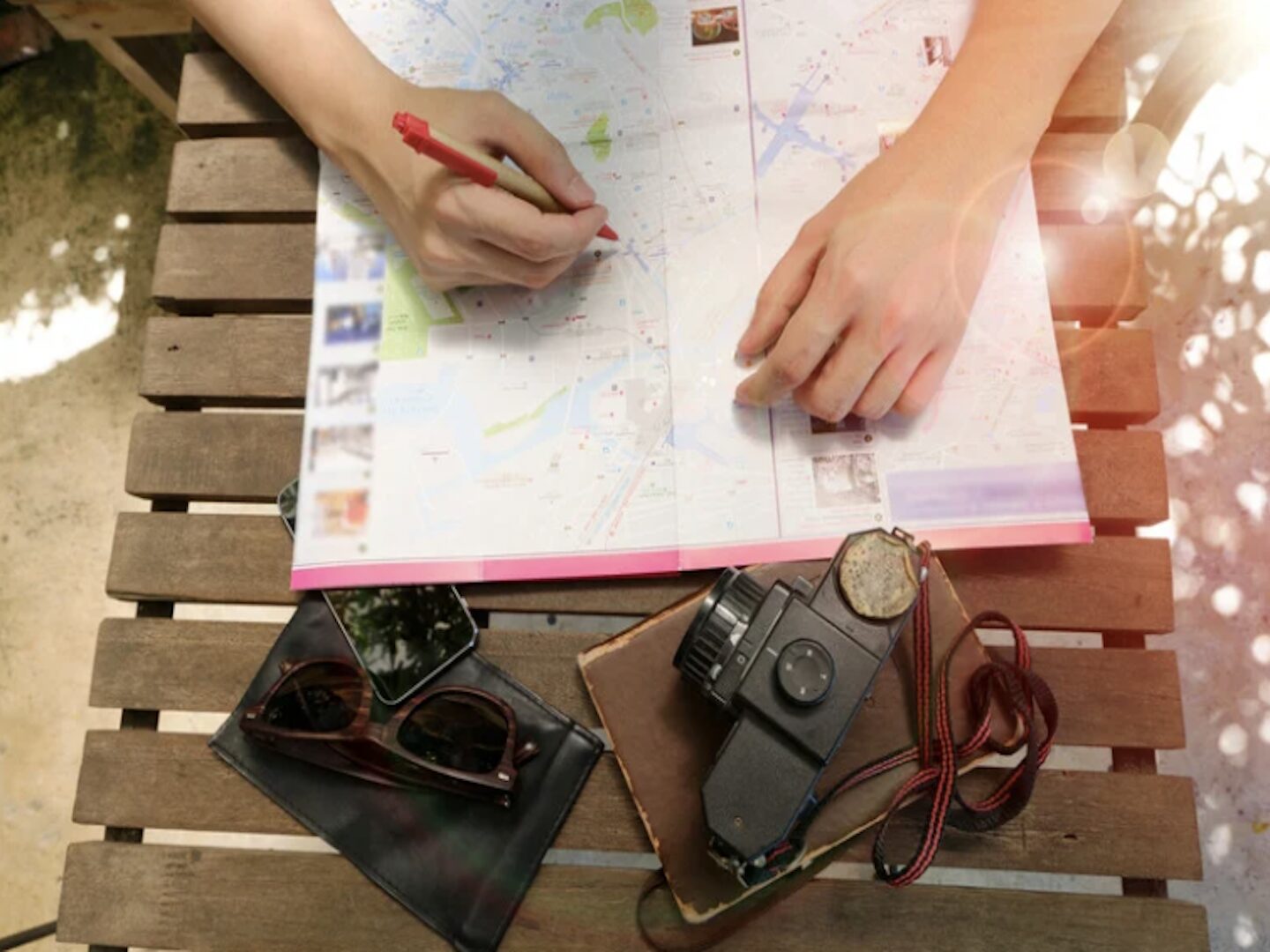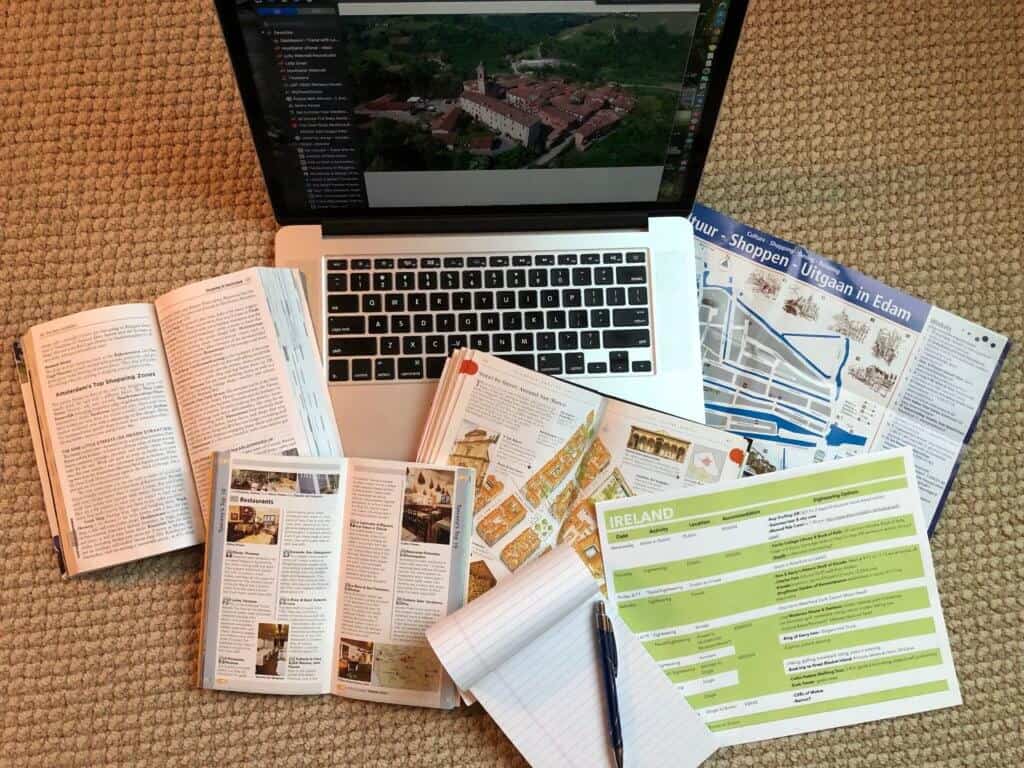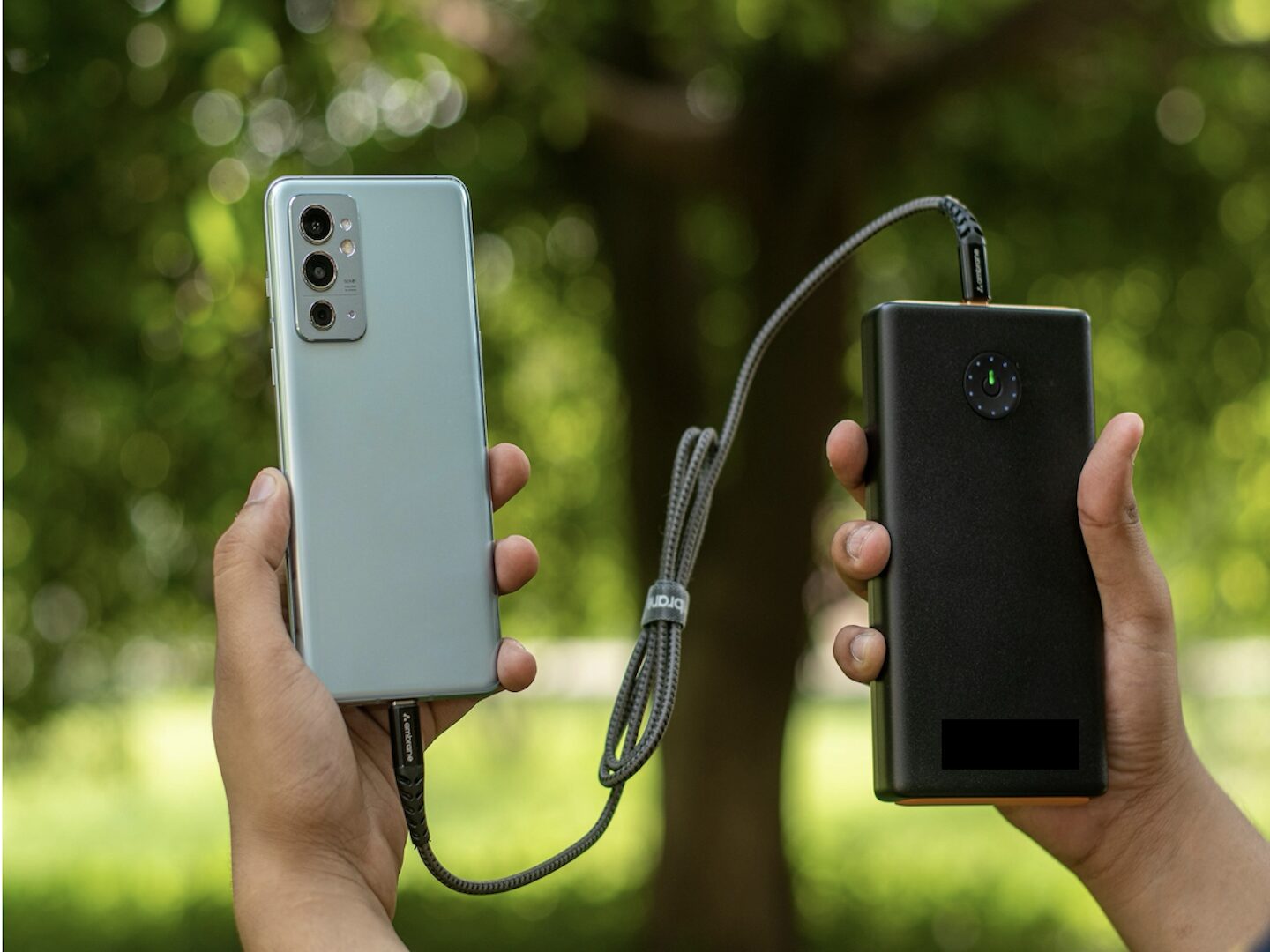You booked the trip—super! Whether it’s a road trip, a dream European getaway, or a visit to North America, locking in transportation and lodging reservations are just the beginning. Here’s your ultimate timeline countdown checklist of what to do (and when to do it) between now and departure. Use this travel planning timeline, so nothing slips through the cracks—and you show up ready for your best trip yet. I’ve used this trip planning timeline for decades, and it’s served me well. Hopefully, it helps you, too!
For important trip planning considerations and steps, please read my article, Wander without Worry: How to Plan a Great Trip. For help creating itineraries, please read my article, Design Perfect Trip Itineraries — On Your Own or with AI.
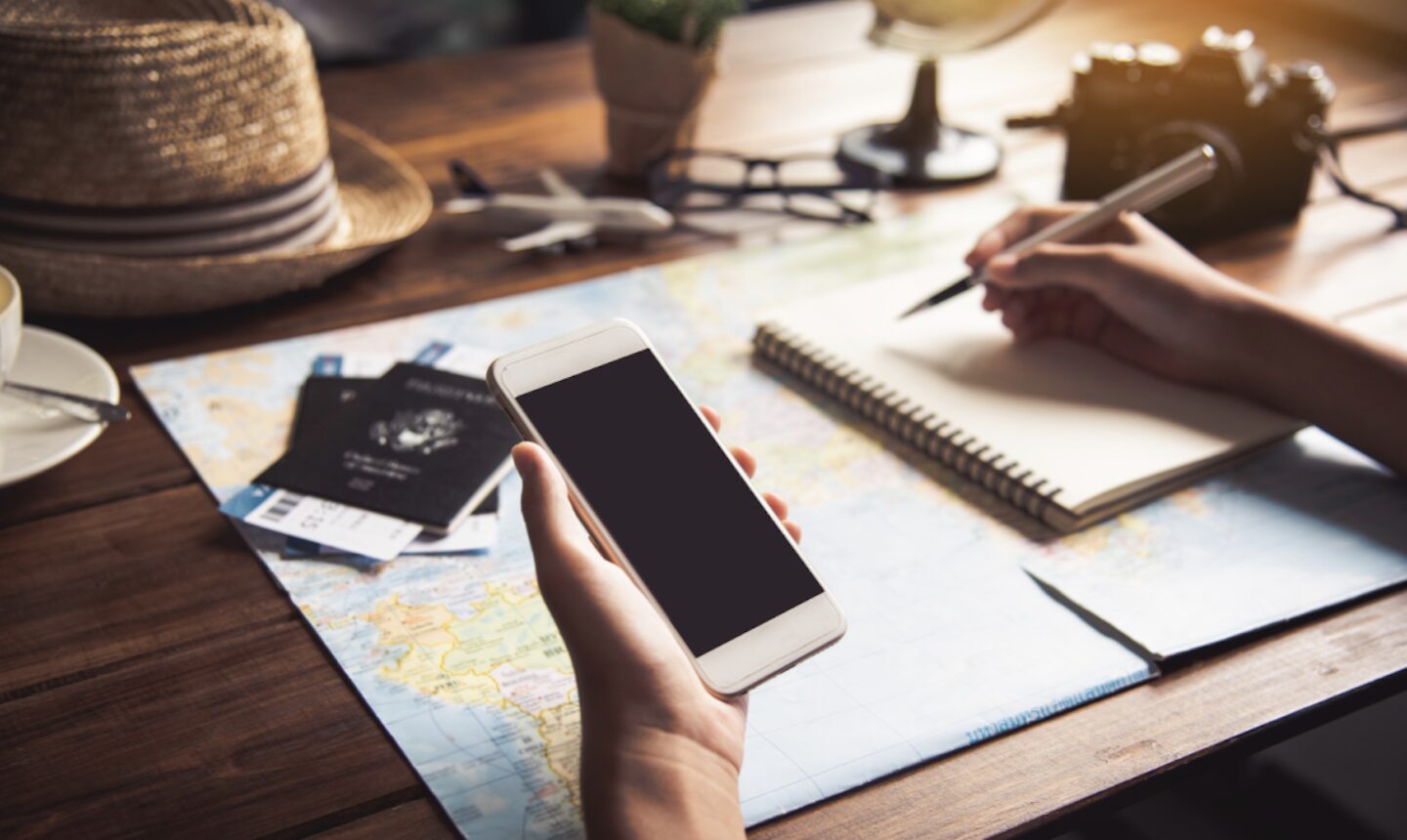
6 -12 MONTHS IN ADVANCE:
- Create a daily itinerary. Start a document with travel dates, destinations, and planned activities. Add specifics (transportation, lodging, tour information) with links as you continue through the planning process.
- Book your transportation (e.g., planes, rental cars, trains, if you haven’t already. Even if you’re joining a pre-planned tour or cruise, you may want to add another destination before joining or after leaving the tour/cruise, but this is especially critical for planning your own trip.
- When flying, booking early lets you capture the departure and arrival times and the cabin level (e.g., economy, premium economy, business class) that align with your plans and budget.
- When renting a car, booking early gives you the best chance of getting the vehicle you want. For instance, if renting a car in Europe, this can mean the difference between getting an automatic and a manual transmission car.
- Book your lodging: Early booking helps ensure you’ll get the type of room you want. For example, do you want a quiet room away from a busy street, a room with a king bed, a room with a view — or all of the above?! Popular places often fill up quickly, so acting soon after you decide where you want to go makes sense.
- Order tour and attraction visits in advance: Oftentimes, you can order tickets online to museums and other experiences in advance and skip the long lines. (It’s always best to book directly with the provider, say a museum.) Some smaller venues restrict entrance to certain windows of time each day. Doing a quick online search of the important experiences on your list will tell you what you need to know.
- Check travel rating sites: Check TripAdvisor, Yelp, or other online rating sites to get ideas for what to do during your downtime, plus get restaurant and lodging tips. You may be surprised to find a side excursion idea you hadn’t thought of or an off-the-main-drag restaurant. But remember that tons of people post to these sites, so go with the consensus and ignore the over-the-top positive or negative comments. It may sound a bit early to think about this, but you never know what you might find and need reservations for months in advance — think cooking classes, boat or jeep tours, and other popular pastimes that tend to fill up fast during peak travel months.
- Buy travel insurance: There are various types, such as medical and trip cancellation. Check your insurance policies and credit card benefits for any coverage you already have. Many health insurance policies do not cover travel outside the country, so verify coverage if planning international travel.
- Budget and save for extras you want to enjoy on your trip.
For international travel, add:
- Check your passport expiration date: Make sure your passport is current for at least 6 months after you expect to return from your trip.
- Consider your country’s expedited aviation travel programs (like TSA Precheck & Global Entry in the U.S.). Enrolling in these programs will ensure a speedier trip through airport security when leaving and returning home.. Check with your credit card company; some will refund the program application money to you.
- Check country-specific travel alerts for safety concerns. One resource is the U.S. Department of State travel website.
- Look into necessary vaccinations or health requirements for your destination.
- Check country-specific entry requirements. Europe instituted new entry requirements to bolster border security in 2025. Some require travelers to apply online for entry approval. The U.K. has the Electronic Traveler Authorization (ETA), the European Union has the Entry-Exit System (EES) and the European Travel Information and Authorization System (ETIAS). Know before you go!
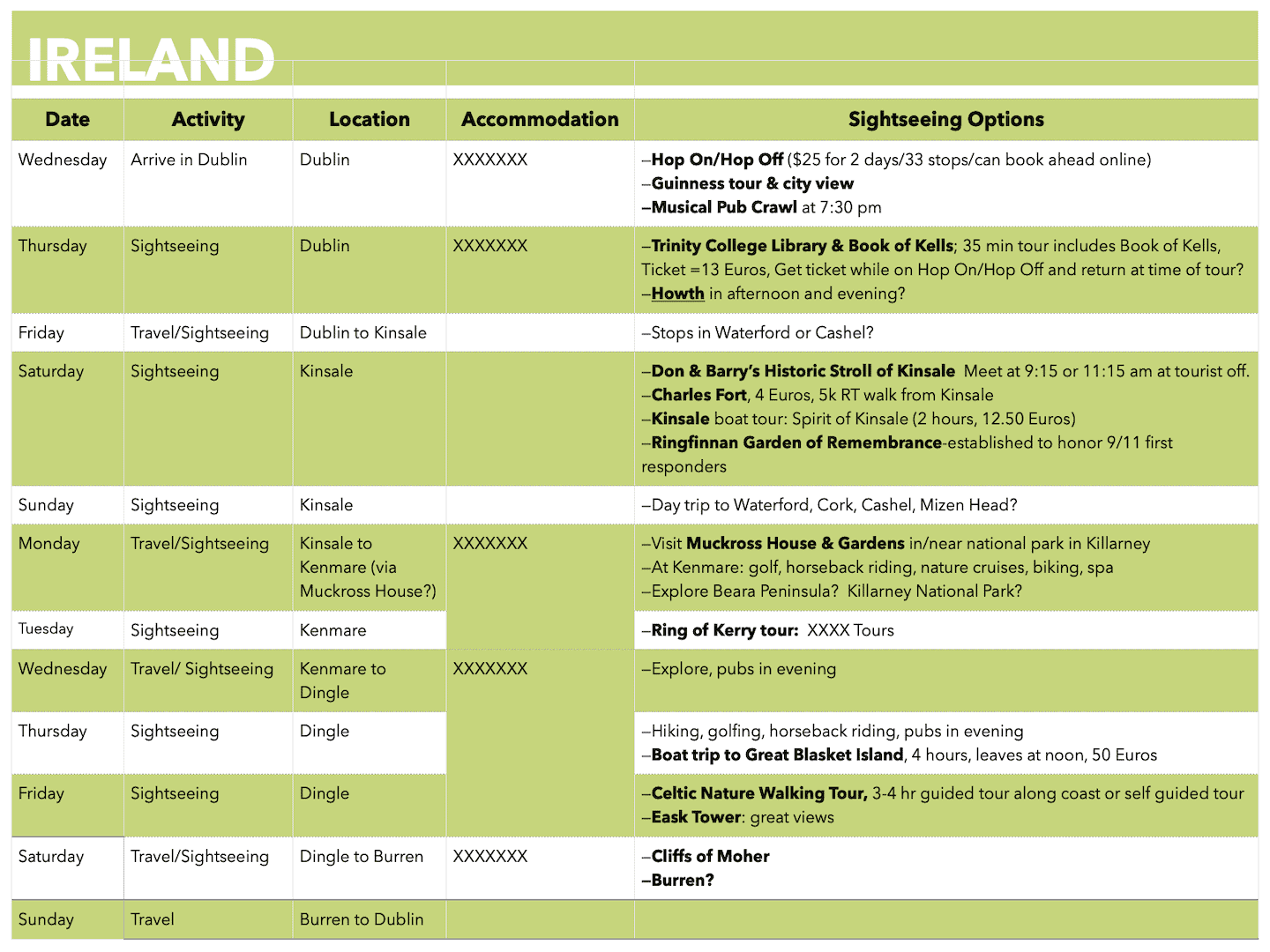
3-6 MONTHS IN ADVANCE:
- Watch videos: Khan Academy and YouTube are stocked with content that can help provide historical and cultural context to your travels. Adding more background knowledge will surely enrich your experience as you can appreciate the art, architecture, customs, and people you meet so much more. Add notes to your itinerary, if needed.
- Decide on luggage options: The debate over checking luggage or using carry-ons continues! Read my article, Traveling Lightly: Top Ten Tips to Pack for Your Next Trip, for more info on traveling with carry-ons only.
For international travel, add:
- Notify banks: Contact your bank (for your debit and credit cards) to inform them of your travel plans. Some still require a call before traveling out of the country. If you don’t, you risk them flagging your account as potentially fraudulent, assuming that your account or cards have been compromised or stolen. While considering your credit cards, check if they impose foreign transaction fees. If they do, consider applying for a card without such fees.
- Get your smartphone ready for travel: Check with your cell service provider to make sure your phone will be able to make and accept calls from home. Or consider purchasing an e-sim to use while away.
- Copy your passport: Although you will always want to carry your passport with you when traveling, having a copy of it in your suitcase (and with a trusted family member or friend) will be a godsend in case you lose your passport along the way.
- Learn basic phrases: Being able to greet the shopkeeper or waiter in their language is always a plus when traveling. It shows an appreciation for them and their country. Google Translate (or other translation app) is a good place to find phrases in a jiffy; not only do you see the word or phrase (which can help, say, when you’re trying to locate the nearest ATM or ask how much something costs), but it also shares the audio equivalent to help make sure you don’t butcher the language too much.
- Get foreign currency: Although it’s easy to get local currency from bank-operated ATMs at your destination and most places accept credit cards for payment, some folks like to start off a trip with some local currency for their destination. If that’s you, order currency from your bank several weeks before departure. When using an ATM to obtain cash in another country’s currency, it’s usually best to request local currency to avoid unfavorable currency conversion rates and fees.
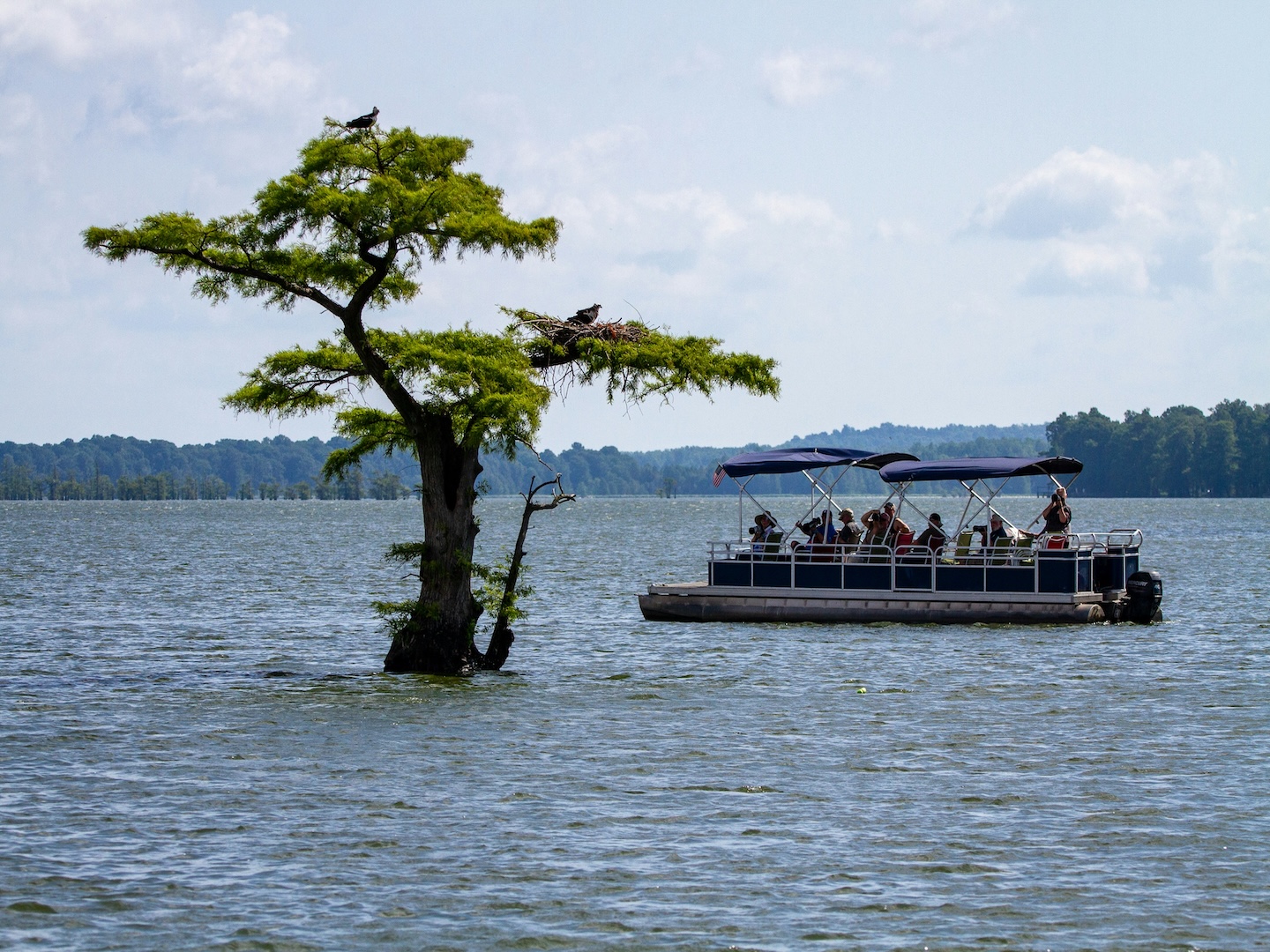
UP TO 3 MONTHS IN ADVANCE:
- Download travel apps: Check my article, Must-Have Travel Apps and Websites, for suggestions. If flying, don’t forget to download your airline’s app to stay updated on any flight changes.
- Get necessary travel gear: Make sure you have the best walking/hiking shoes, day bags, adapters, and other travel gear to make traveling more enjoyable.
- Schedule pet sitting (or child care), if applicable.
- Review transportation, lodging, and tour cancellation policies if plans change.
- Learn more about your destinations from others who live or have traveled there. Join your destination’s Facebook groups, travel blogs, and social media posts.
- Choose a camera option: Are you happy with your smartphone or other camera you have now to take your vacation pictures? If not, now’s the time to research options.
- Watch videos: Khan Academy and YouTube are stocked with content that can help provide historical and cultural context to your travels. Adding more background knowledge will surely enrich your experience as you can appreciate the art, architecture, customs, and people you meet so much more. Add notes to your itinerary, if needed.
- Decide on luggage options: The debate over checking luggage or using carry-ons continues! Read my article, Traveling Lightly: Top Ten Tips to Pack for Your Next Trip, for more info on traveling with carry-ons only.
TWO WEEKS TO GO!
- Confirm all logistics and reservations you made and finalize the itinerary.
- Share your itinerary: Make sure trusted family members or friends know your travel plans: flights, lodging, and daily schedule. Knowing that others know your plans is a great way to find peace of mind in an emergency.
- Create new contacts on your smartphone to include the customer service numbers of your bank (for debit and credit cards), names, numbers, and location of your lodging (location info can be handy when trying to find your way back from a day out), and any tours or experiences you booked – as well as your country’s embassy, if traveling internationally.
- Download maps for offline use while you’re traveling.
- Download content: Have your devices stocked with content (books, audiobooks, magazines, podcasts, movies, music) that will keep you entertained during traveling downtime.
- Reread sections in guidebooks: Refresh yourself with what you’ll be visiting and the context you’re interested in: architecture, art, history, etc.
- Get medications: Make sure your meds are ready for the trip. In addition to prescriptions, remember the over-the-counter meds you usually use and will want to pack.
- If flying, check current aviation regulations regarding what is allowed in your carry-on and checked luggage. Also, verify your luggage’s size and weight limits by checking your airline’s website.
- Stop deliveries: Stop your mail, newspaper deliveries, and any automatic deliveries you may have set up — or have someone pick them up for you.
- Prepay bills for what might come due while away.
- Check the weather forecast and tweak your packing list accordingly. Begin to make final decisions about what to pack.
- Buy travel snacks, a reusable water bottle, and travel comfort items.
- Finalize plans for your home.
- Have someone come over to water your plants inside and out.
- Have a neighbor park in your driveway occasionally to diminish the deserted look while you’re away.
- Get timers to place in certain rooms to have lights turned on each evening to give passersby the illusion that someone is home.
For International Travel, add:
- Set up an international phone/data plan with your carrier or purchase an eSIM for your smartphone.
- Make address cards for cabbies. When traveling internationally, minimize issues when you don’t speak the language well. Write the name, address, and phone number for each place you’ll stay on a different index card or sticky note.. Give the cards/notes to the cabbies who drive you to your hotels/inns/hostels or short-term rentals.
1-2 DAYS BEFORE
- If flying, verify flight times and terminal information.
- Recheck your destination’s weather.
- Finish packing, including final essentials (medications, chargers, documents, IDs, etc.).
- Charge all devices and power banks.
- Empty your fridge and take out the trash.
- Turn the thermostat up or down (depending on the season) if no one will be using your home while you’re traveling.
Related Articles
- Best Tips for Planning the Perfect Road Trip
- Design Perfect Trip Itineraries — On Your Own or with AI
- Expert Tips for Traveling to Europe for More Fun, Less Stress
- How to Create Trip Photo Books to Make Your Travels Last a Lifetime
- How to Find the Perfect Vacation Home Rentals
- Must-Have Travel Apps & Sites
- Stay Powered Up: A Traveler’s Guide to Power Banks
- Travel Lightly: Top Ten Tips to Pack for Your Next Trip
- Wander without Worry: How to Plan a Great Trip
Final Thoughts
This travel planning timeline has served me well for decades, and it’s designed to be flexible. Feel free to move some to-dos around to suit your schedule. Anyway you use it, you’ll be more prepared and less stressed – a great way to start any trip! Happy travels!
Be flexible! Inevitably, there’ll be hiccups — like delays — along the way. Travel doesn’t come without a few inconveniences. But the good experiences most likely will outweigh the bad. Enjoy visiting new places, learning new things, and meeting new people! Enjoy the journey. Build memories. Happy travels!
Comments?
Feel free to share any additions you may have to this timeline. Your input can help fellow travelers. Thanks! 🙂

